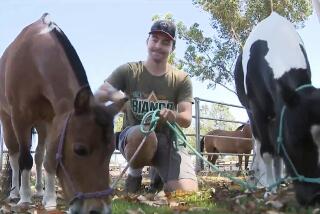Disabled Patients Still Horsing Around
- Share via
For more than a quarter century, the nonprofit Institute of Equestrian Therapy has combined horse riding with physical therapy for children and adults with disabilities.
By combining the two worlds, the rider-patient gets practical therapy and the fun and sport of horsemanship, said founder Jacques Fouchaux, who has 28 students, ages 2 to 30, with disabilities that include muscular dystrophy, cerebral palsy and autism.
“When you ride the horse your whole body moves,” he said, explaining the therapeutic value. “You cannot be still.”
Fouchaux first got the idea for the therapy when a woman approached him and asked if her blind son could take a ride on his horse. “I didn’t know much about disabilities then, but he was very good.”
Now, 26 years later, he has taught hundreds of people with disabilities to ride and care for horses, he said.
“Riding horseback mimics a sense of movement,” Fouchaux said. “The whole body moves.”
Riders groom horses, perform gymnastics and play games, said Tina Wilkins, assistant director. Wilkins is planning to open her own therapy program called “Heaven’s Other Side” in November in Moorpark.
Participants practice pointing their toes, maintaining balance, strengthening muscles and stretching, she said. But she keeps the rides fun.
While riding therapy is unusual, it’s better in some ways, Fouchaux said.
“The problem with therapy is motivation,” Fouchaux said. “Here, the horse is the motivation. They’re doing more than just pleasing a physical therapist.”
Helen Shrager agrees. Her 9-year-old son, Sean, has muscular dystrophy and comes to the school once a week.
“Being around a horse is more enjoyable,” she said. “Indoor therapy is very dry.”
More to Read
Sign up for Essential California
The most important California stories and recommendations in your inbox every morning.
You may occasionally receive promotional content from the Los Angeles Times.













